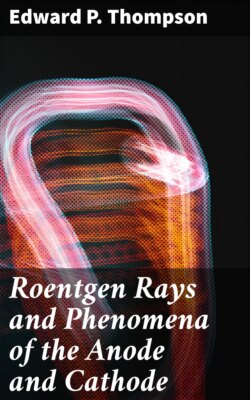Читать книгу Roentgen Rays and Phenomena of the Anode and Cathode - Edward P. Thompson - Страница 7
На сайте Литреса книга снята с продажи.
CHAPTER II
ОглавлениеTable of Contents
VI
28. Davy, Bancalari and Quet’s Experiments. Electric Arc, Magnetism and Flame. Sound Produced. Practical Application of Electric Arc. Phil. Mag., 1801.—When the electric arc, for example between two carbon electrodes, occurs, in a powerful magnetic field, it is violently drawn to one side as first shown by Sir Humphry Davy, as if the wind were blowing it and sometimes it is broken into two parts. Fig. VI. Again a loud noise is produced. § 9. Without the magnet, the appearance is as at the left. With the energized magnet, the arc and light, as a whole, are as shown at the right.
29. De La Rive’s Experiment. Rotation of Luminous Effect by Magnet. Application to Explain Aurora Borealis. Phil Trans., vol. 137, 1847. Pynchon, p. 471. Ganot, Sect. 928.—An oval discharge tube was employed, having a highly exhausted atmosphere (for those days) of spirits of turpentine. A cylindrically shaped pole of a magnet extended into the bulb half way, Fig. 4, p. 17. The inner end of the magnetic pole formed one electrode of the tube, and the other electrode was a ring within the vacuum at the foot of the magnetic pole. A fountain of light extended from one end of the magnet pole to the other, and remained stationary, while the magnet was not energized; but the light was condensed into an arc and travelled around the magnet pole when a current was passed through the coils of the magnet. For similar action of magnet on a flexible and movable wire carrying a current, see experiments of Spottiswoode and Stokes, Proc. R. So., 1875. The aurora borealis rotates around the pole of the earth, and therefore, De La Rive thought that the phenomenon in his laboratory and in nature were but one and the same thing and different only in degree. He also extinguished an arc in open air by means of a powerful magnet.
VII
30. Plücker and Hittorf’s Experiments. Action of Magnet on Cathode Column of Light. Pogg. Ann., 1858 and 1869. Plücker found that the magnet acts on the cathode light in a rarefied atmosphere in a different manner from that on the anode light. In the former the light follows the magnetic curves and strike the side of the bulb, according to position of the poles, see Fig. VII. “Where the discharge is perpendicular to the line of the poles, it is separated into two distinct parts, which can be referred to the different action exerted by the electro-magnet on the two extra currents produced in the discharge.” Ganot. § 925.
31. Thomson’s Experiment. A Discharge Retarded Across and Accelerated Along the Lines of Magnetic Force. Nature, Lon., Jan. 31, 1895, p. 333. Lect. Royal Inst.—Prof. J. J. Thomson, F. R. S., performed an experiment which illustrates that the electrical discharge is retarded in flowing across the lines of magnetic force and accelerated in flowing with or parallel to such lines. As illustrated in Fig. 20, p. 17, he employed a large electro-magnet adapted to be cut in and out of circuit. He had two air chambers, one a bulb, indicated by a circle, and the other a tube bent into a rectangle, indicated by the dotted square. Between these, was an adjustable coil having its terminals connected to the outside coatings of Leyden jars. When the discharge took place between the poles of the magnet, that is, in the direction of the lines of force, the discharge was helped along by the magnetic field, but when it took place across the bulb, that is, across the lines of force, the discharge was retarded. “The coil can be adjusted so that when the magnet is ‘off’ the discharge passes through the bulb, but not round the square tube; when, however, the magnet is ‘on,’ the discharge passes in the square tube but not in the bulb.”
Some Experiments prior to Lenard’s.
32. Thomson’s Experiment. Resistance Offered to Striae by a Thin Diaphragm. Lect. Royal Inst. Nature, Lon. Jan. 31, ’95, p. 333.—It has often been remarked that lightning always takes the easiest path. The same has been noticed with references to the artificial electric spark. Prof. J. J. Thomson, F.R.S. performed an experiment, which not only confirms this principle but does so in an emphatic manner, and proves it true in reference to the electric discharge in rarefied gases. He arranged a very thin platinum diaphragm so as to divide a Geissler tube into two compartments, Fig. 19, p. 17. He then formed a passage way around the diaphragm, which could be opened and closed by mercury, by respectively lowering and raising the lower vessel of mercury along the barometer tube. When the passage way is opened around the diaphragm, the luminosity extends through the passage way in preference to going through the diaphragm. When the passage way is closed by mercury, the discharge goes through the thin metal plate. The same was found to occur when the platinum leaf was replaced by a mica scale.
33. Sir David Solomon’s Experiment in 1894. Proc. Royal So., June 21, ’94. Nature, Lon. Sept. 13, ’94, p. 490.—With a tube having a perforated diaphragm, he noticed a “forcing effect” at and near the hole. The striae had the appearance of being pushed through from the longer part of the tube—the diaphragm not being in the centre. There was no passage way around the diaphragm—only through the small puncture. § 19.
